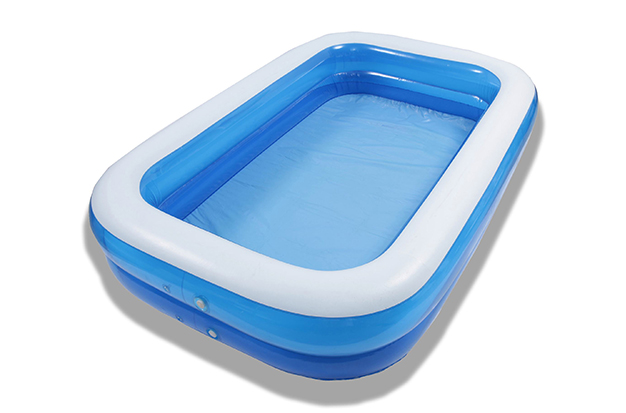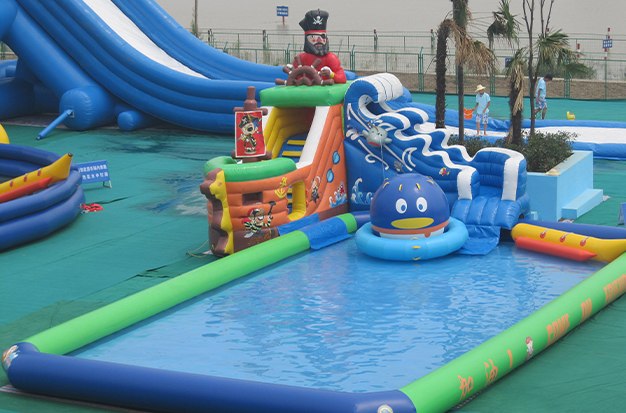How To Keep Inflatable Pool Water Clean?
How can the water in an inflatable pool be kept clean?
Inflatable pools have a number of advantages, including the ability to save money and space. They are simpler to use and maintain than above-ground and in-ground swimming pools. But among other annoyances, algae, leaves, and bacteria will ruin your fun.
You can use the helpful advice in this guide to keep your pool’s water clean. So, let’s dive in!
Why Keep Clean Pool Water At All Times?
For two main reasons, it is imperative to keep the water in your inflatable pool clean.
The first and most crucial argument is that swimming in stagnant water puts you and your family at serious risk for serious health problems.
When water is left standing for a long time, algae and mold begin to grow, which makes the water the ideal habitat for numerous dangerous parasites and bacteria.
The longer the pool water is left untreated, the quicker bacteria can grow.
The second reason is that if mold and algae growth are not routinely cleaned, they may damage the inflatable pool. You can extend the life of your pool by cleaning them frequently.
How Much Chlorine Do Inflatable Pools Need?
No, chlorine is not necessary to keep inflatable pools clean and safe to use. Without the use of chlorine, there are other ways to keep pool water clean. However, chlorine is the most popular method pool owners use to keep the water free of dangerous bacteria.
Chlorine isn’t required for inflatable pools, but it’s one of the most popular ways to keep pool water hygienic and safe for swimming. Waterborne bacteria that could harm swimmers are effectively eliminated by chlorine.
The use of chlorine will be most advantageous for larger inflatable pools. The alternative is a salt water system, which is significantly more expensive than using chlorine, or periodic pool refills. RWIs, or recreational water illnesses, are a concern, so chlorine is advised for use in these bigger inflatable pools.
Chlorine is typically not added to smaller inflatable pools, such as kiddie pools. Small inflatable pool owners typically don’t have to deal with chlorine or pH test kits because these pools are small enough to refill with fresh water fairly easily.
Do Inflatable Pools Need Chemicals?
No, chemicals are not required for inflatable pools to remain sanitary and safe for swimming. To kill harmful bacteria, chlorine will be used in many larger inflatable pools. In larger pools, in addition to chlorine, other chemicals like pH increasers, pH reducers, alkalinity increasers, and cyanuric acid are also used.
If your inflatable pool is big enough, it most likely comes with a pump already installed or has three openings in the liner where you can attach a pump later. The pools that will probably require chlorination are the ones that have a pump and are larger.
These substances will help keep your water balanced and your chlorine system operating efficiently. Cyanuric acid is probably not something you need to be concerned about, but I included it because it is significant.
Cyanuric Acid
Most large inflatable pools can be kept clean with just a few chlorine tabs. To help the chlorine last longer, most chlorine tabs also contain other chemicals like cyanuric acid. To stabilize the chlorine in the water, make sure to buy stabilized chlorine; otherwise, you will need to add cyanuric acid on your own.
Alkalinity Increaser
Your alkalinity and pH levels will rise if you use an alkalinity increaser. Consider an alkalinity booster as your big guns that will almost certainly get you there, and a pH booster as the finishing touch.
PH Increaser / Reducer
For well-balanced pool water, the pH level should be kept between 7.4 and 7.6. Your water is kept in that range with the aid of the pH increaser and reducer. Your alkalinity will be reduced by a pH reducer.

How To Keep Inflatable Pool Water Clean?
Changing the water in your pool every few days is a simple way to keep it clean and fresh throughout the entire season. Your pool looks brand new and is prepared to be filled once more after you drain the water from it and give it a quick wash with a sponge and detergent.
While this might be simple to implement for small kiddie pools, it is more difficult for larger ones. Large pools may require frequent water changes, which can be both time-consuming and expensive.
The good news is that cleaning your inflatable pool doesn’t take as much time or money as it once did!
We’ll discuss a number of cost-effective solutions that will keep your pool water crystal clear all season long with a minimum of effort since we are aware that there isn’t one perfect cleaning technique that suits everyone.
Pool Cover
Covering the pool whenever it’s not in use is the first piece of advice for keeping the water in your inflatable pool clean.
If your pool is located close to plants or trees where leaves, insects, or other debris could fall into the water, covering it is especially beneficial.
Any kind of plastic cover, such as a tarp or a solar pool cover, that you happen to have on hand can be used.
On hot summer days, if your pool is in direct sunlight, be aware that the solar cover will absorb the sun’s energy and hold onto it, warming the water above its normal temperature.
Simply remove the cover a little while beforehand until the water begins to cool off if you want to swim in cooler water.
Pool Vacuum
A pool vacuum is another useful tool for cleaning your pool’s bottom. Numerous varieties in a range of price points are available, along with some automated choices.
A pool vacuum doesn’t have to cost much. Choosing a pool vacuum at a fair price can be a great investment and do the job perfectly well.
Your garden hose or pump should be connected to the vacuum’s water tube. Without any water loss, the jets will generate the suction required to vacuum the debris into the attached bag.
Most, if not all, bugs, dirt, and leaves will be scrubbed off and removed with the aid of the vacuum.
Try scraping any algae or debris off the bottom or sides of your inflatable pool before vacuuming if the vacuum isn’t picking it up. In order to do that, you can use a sponge, brush, or cleaning mitten. Just be careful that it isn’t too tough to avoid damaging the pool’s surface.
A pool brush designed for that purpose is also available.
Pro Tip: By keeping up with your personal hygiene and washing your feet before you enter the pool, you can reduce the amount of debris that finds its way into your pool.
Skimmer Net
A pool skimmer net is the third item you can buy. Depending on the depth and dimensions of your inflatable pool, you can choose from a wide variety of skimmer net sizes and shapes.
While larger bag nets are ideal for deeper cleaning, a flat net can be used to remove any floating debris.
The debris that floats to the surface can be removed using both the pool vacuum and the skimmer net.
Floating Chlorinator
Also referred to as a floating chlorine dispenser, this device helps keep the pool water sanitized and clean with no effort whatsoever, using only chlorine tablets.
For the best outcomes, use it as follows:
- For exact information regarding how many tablets you’ll need for the size of your pool, read the instructions on the chlorine tablet package.
- Open the vents on the bottom of the floater and insert the tablets inside before sealing the lid tightly.
- Put the floater in the water; if you don’t want it to float around, you can tie it to the pool’s side.
- When the previous tablet has completely dissolved, keep checking it and add more tablets.
- When swimming, remove the floater from the water.
Oil-absorbing Sponge
Inflatable pools frequently experience issues with greasy water and slippery walls; if you don’t properly maintain your pool on a regular basis, eventually you’ll run into these issues as well.
Sweat, cosmetics, sunscreen, and natural oils from your body and hair are just a few of the things that can lead to oily films forming on top of the pool water.
Using an oil-absorbing sponge is a very affordable yet effective solution to that issue.
These sponges are hydrophobic, in contrast to ordinary cleaning sponges. This means that when they are submerged in pool water, they only attract and absorb the oils and scum.
A good-quality oil-absorbing sponge can last for almost the entire season without having to be replaced
You can flip the sponge to the other side if you discover that one side has become overly slimy. You can simply take it out, wash it off, and then re-immerse it in the water if it becomes too filthy.
If you want to avoid greasy water and slippery walls, try to refrain from using oily hair or body products like lotions and/or cosmetics before your swims.
Filter Pump
If your inflatable pool doesn’t already have a filter pump, buying one can make cleaning the pool much simpler.
The finer debris that you can’t vacuum or remove with a skimmer net is removed by the filter that the pump draws the water through.
Additionally, it guarantees continuous water circulation, which is necessary to stop algae growth and preserve the water’s freshness for a longer period of time.
The filter pump’s user manual should explain exactly how to connect the filter hoses to the water inlet and outlet in your pool.
You can submerge the filter hoses in the pool’s water if it lacks built-in water outlets. To make the hoses heavier and prevent them from slipping out of the pool, you can attach any reasonably heavy object to them.
Additionally, remember to regularly clean the filter, check for clogs, and replace it as needed.
Do My Pool Chemicals Allow Me To Swim There?
Yes, it is possible to keep a pool clean enough for swimming without using chemicals. The most popular methods include using a saltwater-based system, ozone purification techniques, ultraviolet pool sanitizing lights, or routinely draining and refilling the pool.
When sanitizing an inflatable pool, owners most frequently use a saltwater system or, if the pool is small enough, empty it out and refill it. The cheapest and most straightforward way to make sure the water is safe to swim in is to empty and refill a small inflatable pool or kiddie pool.
How Frequently Should An Inflatable Pool Change Its Water?
You won’t need to change the pool’s water at all if you use a saltwater system or chlorinate the water. You should drain and refill the water in smaller inflatable pools every 2-4 days to prevent the growth of bacteria that could endanger swimmers.
If you use town water, your water already contains a certain amount of chlorine to sanitize it. Depending on how much added chlorine is present in the water, you might be able to wait 5 days or even up to a week before replacing it in that situation.
Conclusion
For worry-free swim sessions and a durable pool, cleaning an inflatable pool and the water inside of it is crucial. There are times when it can be a burden, but this isn’t necessary any longer.
You can spend a fun and safe summer break in your pool with loved ones now that you are aware of how to maintain the water in an inflatable pool, what equipment to buy, and everything there is to know about chemical water treatments.
